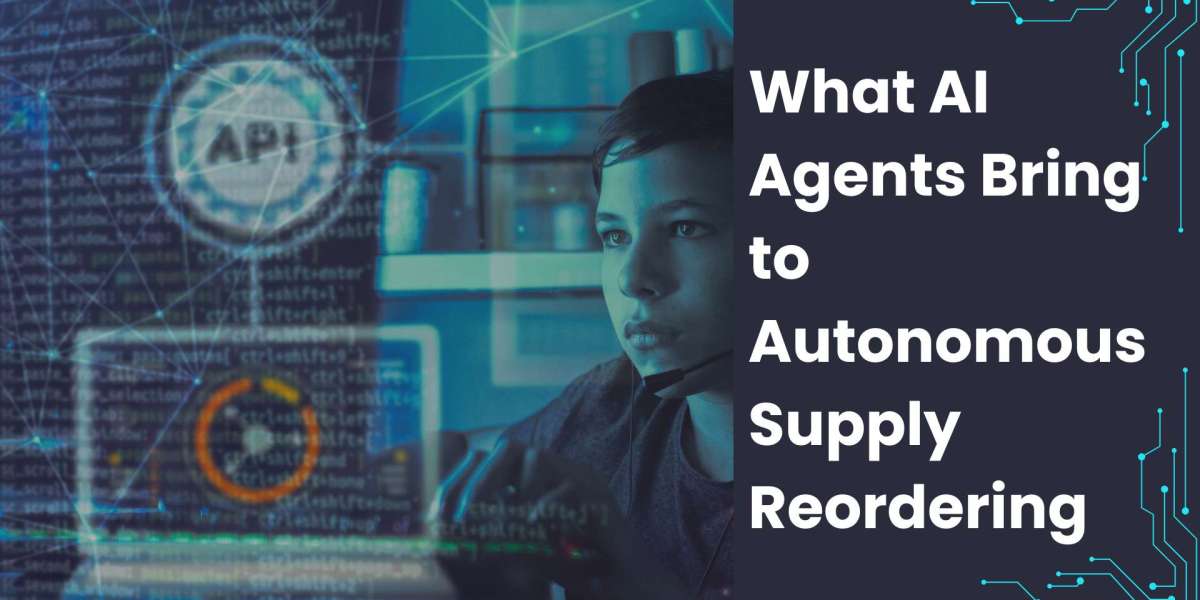In the modern enterprise, supply chains have become more like living organisms than static systems. They react, adapt, and — increasingly — think for themselves. As global supply networks stretch across continents, real-time responsiveness has replaced long-term predictability as the key competitive advantage.
Yet most organizations still operate with outdated logistics workflows: manual approvals, periodic reordering, and reactive decision-making. These legacy processes not only create inefficiencies but also fail to cope with the speed and complexity of global commerce.
Enter AI agents — autonomous, intelligent systems capable of perceiving, deciding, and acting without human intervention. In the realm of supply reordering, they’re reshaping how inventory moves, how procurement triggers happen, and how organizations prevent both shortages and surpluses.
What makes AI agents revolutionary is their ability to learn continuously from every transaction, forecast shifts in demand and supply, and execute orders autonomously — building supply chains that don’t just operate efficiently but self-regulate intelligently.
The Supply Chain’s New Reality
The volatility problem
The last decade exposed a painful truth: even the most optimized supply chain can break overnight. From pandemics and geopolitical shifts to fluctuating raw material costs, unpredictability has become the norm.
Global enterprises are now grappling with:
Supply-demand imbalances caused by external disruptions
Inventory waste due to overstocking safety buffers
Operational latency in manual reordering processes
Rising costs associated with inefficient procurement cycles
Traditional supply chain management systems can track, but they can’t respond. They rely on human analysts to detect anomalies and initiate corrective actions. The lag between detection and decision often translates into lost revenue and reduced agility.
The rise of autonomous supply networks
AI agents are enabling the transition from reactive to autonomous operations. They ingest live data from IoT sensors, ERP systems, supplier APIs, and logistics platforms, turning fragmented inputs into predictive and actionable intelligence.
The result: supply networks that reorder themselves — not periodically, but continuously, based on real-time data and learned patterns.
Understanding AI Agents in Supply Reordering
An AI agent is not just an algorithm. It’s a software entity that can perceive its environment, learn from interactions, and make decisions aligned with predefined goals. In autonomous reordering, that goal is clear — maintain optimal inventory levels without human intervention.
Core capabilities include:
Perception: Capturing signals from warehouse sensors, sales transactions, and external events.
Prediction: Anticipating demand shifts using machine learning models.
Decision-making: Determining when, what, and how much to reorder.
Action: Executing orders directly through procurement systems or supplier APIs.
Learning: Continuously improving through feedback loops.
AI agents can handle complex supply decisions at micro and macro scales — from reordering a single SKU in one warehouse to recalibrating global procurement policies across hundreds of suppliers.
How AI Agents Automate the Reordering Cycle
Autonomous reordering involves far more than setting “minimum stock” alerts. It’s a dynamic process where AI agents assess real-time context, balance priorities, and execute optimized actions.
Here’s how they bring intelligence to each phase:
1. Continuous Demand Sensing
Traditional systems depend on static demand forecasts, often updated monthly or quarterly. AI agents perform continuous demand sensing — analyzing:
Live sales transactions
Market trends and seasonality
Supplier lead times
Promotional impacts
Regional demand signals
Using advanced time-series and deep learning models, they predict demand shifts before they occur. This proactive sensing ensures the system always “knows” when reordering will soon be needed.
2. Contextual Inventory Monitoring
AI agents maintain a real-time digital twin of inventory systems. They track stock not as static numbers, but as dynamic entities influenced by multiple variables:
Shipping delays
Quality rejections
Consumption spikes
Weather or logistic constraints
This contextual awareness allows AI agents to determine whether low stock truly signals reordering — or if alternative fulfillment routes can be leveraged first.
3. Smart Supplier Coordination
AI agents communicate directly with supplier systems via APIs, negotiating reorders based on predicted needs, contract terms, and performance history.
They can:
Prioritize suppliers with shorter lead times or higher reliability
Negotiate dynamic pricing based on real-time market rates
Schedule staggered deliveries to prevent overstocking
Essentially, they act as autonomous procurement specialists — making decisions once handled by supply managers, but at machine speed.
4. Automated Purchase Execution
Once reorder conditions are met, the AI agent triggers purchase orders automatically. But it doesn’t stop there — it tracks confirmation, monitors delivery, and adjusts future forecasts based on supplier response times and accuracy.
This level of closed-loop automation ensures orders are not just placed but verified and optimized continuously.
The Intelligence Framework: How AI Agents Think
Executives often ask, “What makes an AI agent’s decision trustworthy?” The answer lies in its underlying intelligence architecture.
Key analytical components:
Predictive Analytics: Forecasts demand based on multiple correlated signals.
Prescriptive Optimization: Evaluates trade-offs (e.g., cost vs. speed) to recommend or execute the best reorder decision.
Reinforcement Learning: Improves reorder accuracy through trial, feedback, and reward systems.
Causal Inference: Identifies root causes behind supply anomalies, not just correlations.
AI agents blend these capabilities within a self-learning framework, making their behavior explainable, auditable, and adaptable.
Business Benefits: From Cost Reduction to Strategic Agility
AI agents deliver measurable improvements across procurement, logistics, and financial operations.
1. Inventory Optimization
Maintaining too much inventory ties up working capital; too little risks lost sales. AI agents strike the ideal balance.
Reduce overstocking by 25–40%
Minimize stockouts and lost sales
Optimize reorder frequency based on real-time trends
2. Procurement Efficiency
By automating negotiation, approvals, and purchase cycles, enterprises experience:
Up to 60% reduction in manual procurement tasks
Shorter order-to-delivery times
Consistent supplier performance tracking
3. Predictive Risk Mitigation
AI agents don’t just react to disruptions — they anticipate them. For example, if a shipping port closure or raw material shortage is detected, the agent dynamically reroutes orders or switches suppliers.
4. Reduced Operational Costs
Automation slashes the need for manual supervision and error correction. Agents manage repetitive workflows, allowing human teams to focus on strategic sourcing and supplier relationships.
5. Enhanced Forecast Accuracy
AI-driven reordering eliminates the lag of human recalibration. Forecast accuracy improves over time, translating to lower carrying costs and faster cash flow turnover.
From Reactive Systems to Self-Healing Supply Chains
AI agents mark the evolution from automation to autonomy — supply systems that self-correct.
When demand surges unexpectedly, AI agents automatically:
Detect consumption spikes.
Check alternative warehouses or distribution centers.
Trigger replenishment from the most cost-effective supplier.
Adjust safety stock thresholds for future cycles.
This self-healing architecture ensures resilience even under disruption — the hallmark of future-ready supply ecosystems.
Governance and Ethical Oversight
Autonomy must never mean absence of control. As AI agents take on critical business decisions, executives must enforce clear governance frameworks.
Key governance principles:
Transparency: Every reorder decision must be explainable and traceable.
Accountability: Define escalation paths for exceptions or failures.
Bias Detection: Ensure agent decisions aren’t skewed toward certain suppliers.
Compliance: Align reordering policies with regulatory and sustainability standards.
The most successful enterprises blend autonomy with oversight — ensuring AI agents operate within ethical and strategic boundaries.
Building the Infrastructure: What Enterprises Need
Deploying AI agents for autonomous reordering isn’t just about software — it requires a strong data and systems backbone.
1. Unified Data Architecture
Integrate ERP, WMS, CRM, and IoT data streams. AI agents require seamless visibility across the entire supply network.
2. Real-Time Analytics Platform
Implement a cloud-native environment capable of processing and analyzing live data at scale.
3. API-Driven Supplier Networks
Suppliers must expose APIs or data feeds for autonomous agents to interact directly with their systems.
4. Simulation Environments
Before deployment, use digital twins to simulate reordering behavior and test how agents respond to disruptions.
5. Cross-Functional Collaboration
Bring together data scientists, procurement specialists, and IT architects to define rules, metrics, and feedback loops.
These components form the foundation of a cognitive supply infrastructure where AI agents operate seamlessly and securely.
Measuring ROI and Performance
C-level leaders will rightly ask: “What’s the ROI of autonomous reordering?”
Here’s how enterprises measure success:
Inventory Turnover Ratio: Higher turnover with lower working capital.
Order Accuracy Rate: Reduction in incorrect or delayed orders.
Forecast Precision: Improved accuracy leads to predictable margins.
Cost per Order: Lower administrative and operational costs.
Service Level Improvement: Consistent on-time fulfillment, even during volatility.
Early adopters report ROI acceleration within the first 6–12 months of implementation, as agents optimize both routine and exception-based decisions.
The Human Factor: Redefining Roles in the Supply Chain
AI agents don’t eliminate human input — they elevate it.
As agents take over repetitive workflows, supply chain professionals evolve into strategic overseers, focusing on:
Supplier innovation and relationship building
Risk mitigation strategy
Data governance and ethical oversight
Continuous improvement through simulation and monitoring
In this model, humans and AI collaborate symbiotically — humans define the “why,” AI agents execute the “how.”
The Future: Fully Autonomous Commerce
AI agents represent the final step toward autonomous commerce — a future where supply, demand, and logistics are synchronized without manual intervention.
We’re approaching a time when:
Inventory systems reorder themselves.
Pricing adjusts dynamically to raw material fluctuations.
Logistics routes optimize in real time based on weather and congestion.
Procurement cycles operate 24/7 without human supervision.
For forward-thinking enterprises, this isn’t a vision — it’s a roadmap. Autonomous supply reordering is the first milestone on the journey toward a self-operating enterprise.
Conclusion
AI agents are redefining the core of supply management — replacing reactive workflows with proactive intelligence. They analyze patterns, make data-driven decisions, and execute procurement autonomously, ensuring that businesses never run short, overstock, or fall behind demand curves.
By embedding intelligence directly into the supply chain, organizations achieve agility, resilience, and cost efficiency previously unattainable through human-managed systems.
To build such self-evolving ecosystems, partnering with an experienced AI agent development company offers the strategic and technical expertise necessary to design, deploy, and scale autonomous reordering solutions across global operations.








